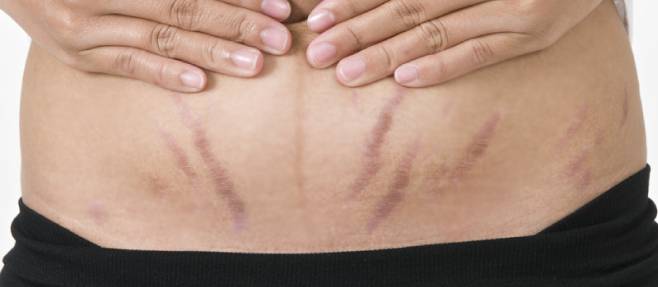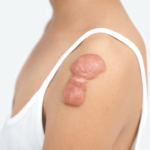
- Dr. Ujwal Chirde
- September 6, 2024
Smooth Skin Ahead: Tips and Tricks for Reducing Stretch Marks
Stretch marks are a common skin concern that many people experience at some point in their lives. These streaks or lines, often appearing on the abdomen, thighs, hips, breasts And arms can be a source of frustration. But don’t worry there are ways to reduce their appearance and regain smooth, glowing skin. At Athera Clinic, Dr. Ujwal Chirde offers expert advice on managing and minimizing stretch marks.
Understanding Stretch Marks
- What Are Stretch Marks?
- Stretch marks, or “striae,” occur when the skin stretches or shrinks rapidly due to weight changes, pregnancy, growth spurts or hormonal changes.
- They are caused by the tearing of the dermis, the middle layer of skin, which leads to the formation of scars.
- Who Gets Stretch Marks?
- Anyone can develop stretch marks regardless of age or gender.
- They are more common during puberty, pregnancy, rapid weight gain or loss and muscle building.
- What Do Stretch Marks Look Like?
- Fresh stretch marks usually appear as red, purple or pink streaks.
- Over time, they may fade to a lighter, silvery color but they rarely disappear completely.
Symptoms
Stretch marks don’t look alike. They vary depending on how long you’ve had them, what caused them, where they are on your body and the type of skin you have. Common variations include:
- Indented streaks or lines on the abdomen, breasts, hips, buttocks or other places on the body
- Pink, red, discolored, black, blue or purple streaks
- Bright streaks that fade to a lighter color
- Streaks covering large areas of the body
Who do stretch marks affect?
Anyone can get stretch marks. But you’re more likely to develop stretch marks if:
- You’re pregnant, especially if you’re Black, Hispanic, East Asian or South Asian.
- You suddenly gain or lose a lot of weight.
- Your muscles get bigger quickly through bodybuilding or weightlifting.
- You’re experiencing a growth spurt during adolescence.
- You have a family history of stretch marks (genetics).
- You have Cushing’s syndromeor Marfan syndrome.
- You’ve been on prednisonelong-term.
Tips and Tricks for Reducing Stretch Marks
- Moisturize Regularly
- Keeping your skin well-hydrated is one of the best ways to prevent and reduce stretch marks.
- Use creams or oils that contain ingredients like cocoa butter, shea butter or hyaluronic acid to nourish your skin and improve elasticity.
- Maintain a Healthy Diet
- A balanced diet rich in vitamins and minerals can support skin health.
- Vitamins A, C, and E along with zinc and silica are particularly important for skin regeneration and collagen production.
- Stay hydrated by drinking plenty of water to keep your skin supple and elastic.
- Stay Active
- Regular exercise helps maintain a stable weight, reducing the likelihood of rapid skin stretching.
- Incorporate strength training and flexibility exercises to promote even muscle growth and skin resilience.
- Use Topical Treatments
- There are various creams, lotions and oils available that are designed to reduce the appearance of stretch marks.
- Look for products containing retinoids, glycolic acid, or peptides as these can stimulate collagen production and improve skin texture.
- Apply these treatments consistently as results may take several weeks to become noticeable.
- Consider Professional Treatments
- For more stubborn stretch marks, professional treatments can offer more significant results.
- Laser Therapy: This treatment uses focused light to stimulate collagen and elastin production, helping to fade stretch marks.
- Microneedling: Tiny needles are used to create micro-injuries in the skin, promoting natural healing and collagen production.
- Chemical Peels: These involve applying a chemical solution to the skin, which exfoliates the top layers and promotes new skin growth.
- Microdermabrasion: A non-invasive procedure that gently exfoliates the skin, improving texture and reducing the appearance of stretch marks.
- Practice Patience
- Reducing stretch marks takes time and it’s important to be patient and consistent with your skincare routine.
- Over time, with regular care and treatment, you should see an improvement in the appearance of your stretch marks.
Prevention Tips for Stretch Marks
- Maintain a Stable Weight
- Avoid rapid weight gain or loss by maintaining a balanced diet and regular exercise routine.
- If you’re pregnant, focus on gradual, steady weight gain as recommended by your healthcare provider.
- Nourish Your Skin During Pregnancy
- Pregnant women are particularly prone to stretch marks, so it’s important to take extra care of your skin.
- Use pregnancy-safe creams or oils that are rich in vitamin E and other moisturizing ingredients.
- Stay Hydrated
- Drink plenty of water daily to keep your skin hydrated from the inside out.
- Proper hydration helps your skin maintain elasticity, which can prevent the formation of stretch marks.
- Avoid Steroid Use
- Long-term use of corticosteroids can weaken the skin’s collagen, making it more susceptible to stretch marks.
- Always consult your doctor before using steroid creams or medications.
Myths About Stretch Marks
- Myth: Only Women Get Stretch Marks
- While stretch marks are commonly associated with pregnancy, they can affect anyone, including men, especially during puberty or rapid muscle growth.
- Myth: Stretch Marks Can Be Completely Erased
- While there are many treatments available that can significantly reduce the appearance of stretch marks, they are unlikely to disappear entirely.
- The goal is to minimize their appearance and improve the overall texture and tone of your skin.
- Myth: Expensive Products Are Always Better
- The effectiveness of a product depends on its ingredients and how consistently you use it, not its price.
- Look for products with proven ingredients like retinoids, hyaluronic acid or natural oils.
Consult with Dr. Ujwal Chirde at Athera Clinic
If you’re struggling with stretch marks and looking for expert advice and treatment options, Dr. Ujwal Chirde at Athera Clinic is here to help. With a deep understanding of skin health and a range of professional treatments available, Dr. Chirde can guide you on the best course of action to achieve smoother, more even-toned skin.
Conclusion
Stretch marks are a common skin concern, but with the right care and treatment, their appearance can be significantly reduced. By moisturizing regularly, maintaining a healthy lifestyle and considering professional treatments when needed, you can improve your skin’s texture and regain confidence. For personalized advice and advanced treatments, visit Dr. Ujwal Chirde at Athera Clinic, where smooth beautiful skin is within reach.





